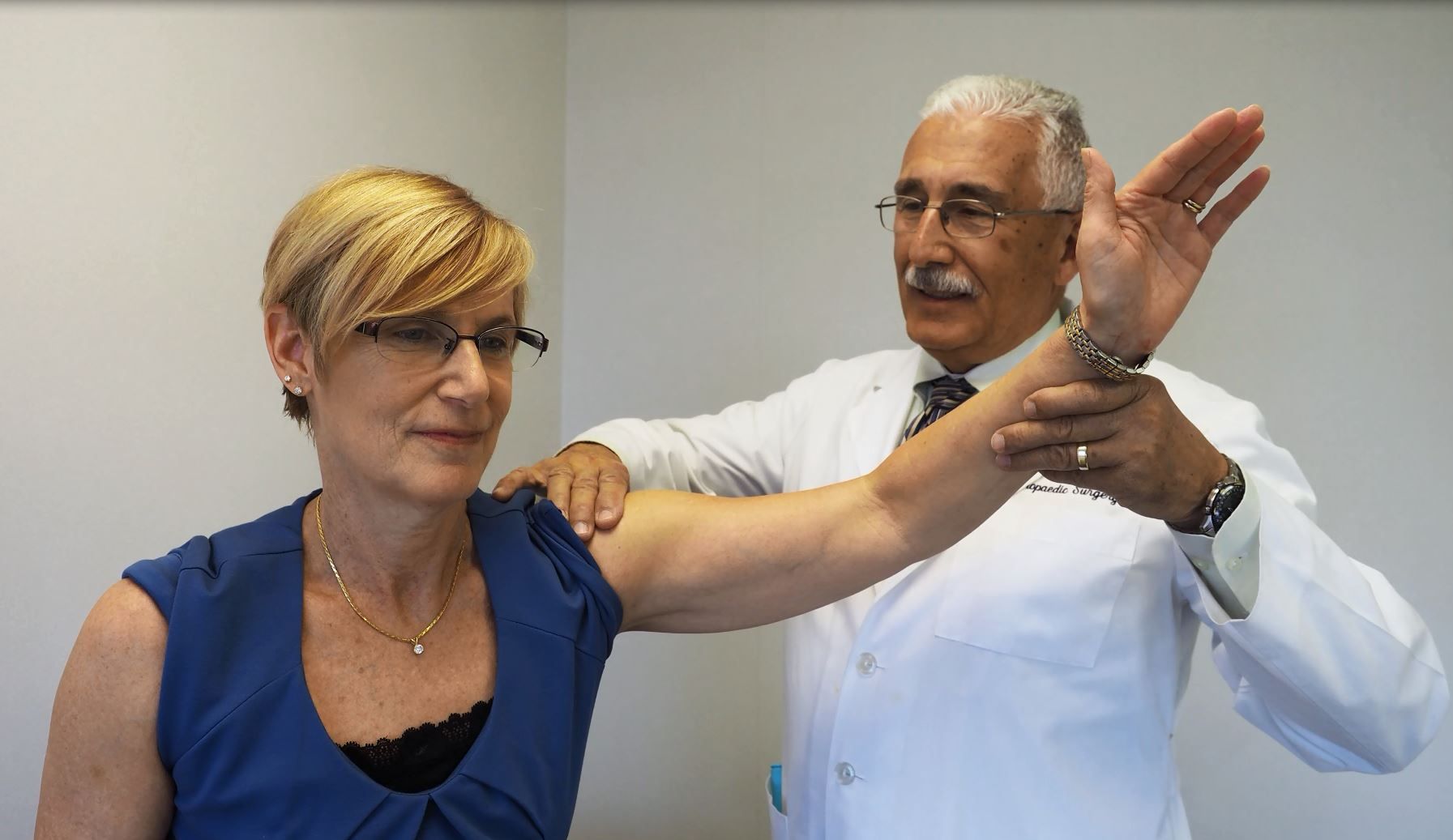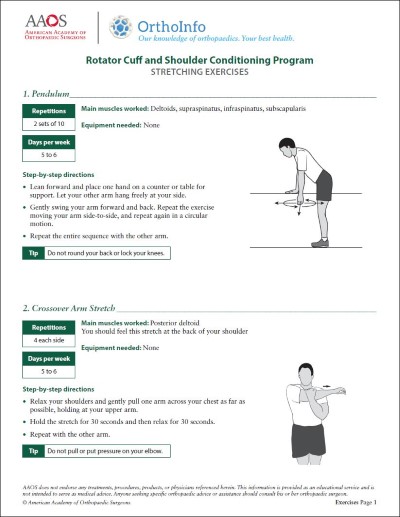Treatment
Shoulder Arthroscopy
Arthroscopy is a procedure that orthopaedic surgeons use to inspect, diagnose, and treat problems inside a joint.
The word arthroscopy comes from two Greek words, "arthro" (joint) and "skopein" (to look). The term literally means "to look within the joint." During shoulder arthroscopy, your surgeon inserts a small camera, called an arthroscope, into your shoulder joint. The camera displays pictures on a video monitor, and your surgeon uses these images to guide miniature surgical instruments.
Because the arthroscope and surgical instruments are thin, your surgeon can use very small incisions (cuts), rather than the larger incisions needed for standard, open surgery. This results in less pain for patients and shortens the time it takes to recover and return to favorite activities.
Shoulder arthroscopy has been performed since the 1970s. It has made diagnosis, treatment, and recovery from surgery easier and faster than was once thought possible. Improvements to shoulder arthroscopy occur every year as new instruments and techniques are developed.
Anatomy
The shoulder is a complex joint that is capable of more motion than any other joint in the human body. It is made up of three bones:
- The upper arm bone (humerus)
- The shoulder blade (scapula)
- The collarbone (clavicle)
Ball-and-socket. The head of the upper arm bone fits into a rounded socket in the shoulder blade. This socket is called the glenoid. A slippery tissue called articular cartilage covers the surface of the ball and the socket. It creates a smooth, frictionless surface that helps the bones glide easily across each other.
The glenoid is ringed by strong fibrous cartilage called the labrum. The labrum forms a gasket around the socket, adds stability, and cushions the joint.
Shoulder capsule. The joint is surrounded by bands of tissue called ligaments. They form a capsule that holds the joint together. The undersurface of the capsule is lined by a thin membrane called the synovium. It produces synovial fluid that lubricates the shoulder joint.
Rotator cuff. Four tendons surround the shoulder capsule and help keep the arm bone centered in the shoulder socket. This thick tendon material is called the rotator cuff. The cuff covers the head of the humerus and attaches it to the shoulder blade.
Bursa. There is a lubricating sac called a bursa between the rotator cuff and the bone on top of your shoulder (acromion). The bursa helps the rotator cuff tendons glide smoothly when you move your arm.
When Shoulder Arthroscopy Is Recommended
Your doctor may recommend shoulder arthroscopy if you have a painful condition that does not respond to nonsurgical treatment. Nonsurgical treatment includes:
- Rest
- Physical therapy
- Medications or injections that can reduce inflammation and allow injured tissues to heal (inflammation is one of your body's normal reactions to injury or disease; in an injured or diseased shoulder joint, inflammation causes swelling, pain, and stiffness)
Injury, overuse, and age-related wear and tear are responsible for most shoulder problems. Shoulder arthroscopy may relieve painful symptoms of many problems that damage the rotator cuff tendons, labrum, articular cartilage, and other soft tissues surrounding the joint.
Common arthroscopic procedures include:
- Rotator cuff repair
- Removal or repair of the labrum
- Repair of ligaments
- Removal of inflamed tissue or loose cartilage
- Repair for recurrent shoulder dislocation (chronic shoulder instability)
Less common procedures such as nerve release, fracture repair, and cyst excision can also be performed using an arthroscope. Some surgical procedures, such as shoulder replacement, still require open surgery with larger incisions.
Planning for Surgery
Evaluations and Tests
Your orthopaedic surgeon may ask you to see your primary doctor to make sure that you do not have any medical problems that need to be addressed before your surgery. Blood tests, an electrocardiogram, or a chest X-ray may be needed to safely perform your surgery.
If you have certain health risks, a more extensive evaluation may be necessary before your surgery.
Admissions Instructions
If you are generally healthy, your arthroscopy will most likely be performed as an outpatient procedure. This means you will not need to stay overnight at the hospital.
Be sure to inform your orthopaedic surgeon of any medications or supplements that you take. You may need to stop taking some of these prior to surgery.
The hospital or surgery center will contact you ahead of time to provide specific details about your procedure. Make sure to follow the instructions on when to arrive and especially on when to stop eating or drinking prior to your surgery.
Anesthesia
Before the operation, a member of the anesthesia staff will talk with you about anesthesia options.
- Shoulder arthroscopy may be performed using a regional nerve block, which numbs your shoulder and arm. This numbing medicine is injected in the base of your neck or high on your shoulder. This is where the nerves that control feeling in your shoulder and arm are located. In addition to its use as an anesthetic during surgery, a nerve block will help control pain for several hours after the surgery is completed.
- Many surgeons combine nerve blocks with a light general anesthetic because patients can become uncomfortable staying in one position for the length of time needed to complete the surgery. General anesthesia puts you to sleep.
Most arthroscopic procedures take less than 2 hours. However, the length of your surgery will depend on what your surgeon finds and what repairs are required.
Surgical Procedure
Positioning and Preparation
Once in the operating room, you will be positioned so that your surgeon can easily adjust the arthroscope to have a clear view of the inside of your shoulder. The two most common patient positions for arthroscopic shoulder surgery are:
- Beach chair position. This is a semi-seated position similar to sitting in a reclining chair.
- Lateral decubitus position. In this position the patient lies on their side on an operating table.
Each position has some slight advantages. Surgeons select positions based on the procedure being performed, as well as their individual training.
Once you are positioned, the surgical team will:
- Remove (shave) hair, if needed
- Spread an antiseptic solution over your shoulder to clean the skin.
- Cover your shoulder and arm with sterile drapes
- Most likely place your forearm in a holding device to ensure your arm stays still during the procedure
Procedure
- Your surgeon may inject fluid into the shoulder to inflate the joint. This makes it easier to see all the structures of your shoulder through the arthroscope.
- Then, your surgeon will make a small puncture in your shoulder (about the size of a buttonhole) for the arthroscope. Fluid flows through the arthroscope to keep the view clear and control any bleeding. Images from the arthroscope are projected on the video screen, showing your surgeon the inside of your shoulder and any damage.
- Once the problem is clearly identified, your surgeon will insert other small instruments through separate incisions to treat it. Specialized instruments are used for tasks like shaving, cutting, grasping, suture passing, and knot tying. In many cases, special devices are used to anchor stitches into bone.
- Once the procedure is done, your surgeon will close your incisions with either stitches or steri-strips (small Band-Aids) and cover them with a large, soft bandage.
Recovery
Post-operative
After surgery, you will stay in the recovery room for 1 to 2 hours before being discharged home. Nurses will monitor your responsiveness and provide you with pain medication, if needed. You will need someone to drive you home and stay with you for at least the first night.
At Home
Although recovery from arthroscopy is often faster than recovery from open surgery, it may still take weeks to months for your shoulder joint to completely recover.
You can expect some pain and discomfort for several weeks after surgery. If you have had a more extensive surgery, however, it may take longer before your pain subsides. Ice will help relieve pain and swelling. Your doctor may prescribe pain medicine, if needed.
Treating pain with medications can help you feel more comfortable, which will help your body heal faster and recover from surgery faster. Many types of pain medication are available to help control pain, including:
- Opioids
- Nonsteroidal anti-inflammatory drugs (NSAIDs)
- Local anesthetics
Opioids can provide excellent pain relief; however, they are narcotics and can be addictive. It is important to use opioids only as directed by your doctor and to stop taking them as soon as your pain starts to improve.
Although it does not affect how your shoulder heals, lying flat may pull on your shoulder and cause discomfort. Some patients are more comfortable sleeping in a reclining chair or propped up in bed the first days after surgery.
A few days after surgery, you should be able to replace your large bandage with simple Band-Aids. You may shower once your wounds are no longer draining, but try not to soak or scrub your incisions.
You will most likely need a sling or special immobilizer to protect your shoulder. Your surgeon will discuss with you how long the sling will be needed.
Rehabilitation
Rehabilitation plays an important role in getting you back to your daily activities. Your surgeon will develop a rehabilitation plan based on the surgical procedures you required.
An exercise program will help you regain shoulder strength and motion. If you have had a more complicated surgical repair, your surgeon may recommend a physical therapist to supervise your exercise program.
For your surgery to be a success, it is important that you make a strong effort at rehabilitation.
Complications
Most patients do not experience complications from shoulder arthroscopy. As with any surgery, however, there are some risks. These are usually minor and treatable. Potential problems with arthroscopy include:
- Infection
- Excessive bleeding
- Blood clots
- Damage to blood vessels or nerves
Your surgeon will discuss the possible complications with you before your operation.
Long-Term Outcomes
Because patients have varied health conditions, complete recovery time is different for everyone.
- If you have had a minor repair:
- You may not need a sling
- Your strength may return after a short period of rehabilitation.
- You may be able to return to work or school within a few days of your procedure.
- It takes longer to recover from more complicated procedures. Although the incisions are small in arthroscopy, the procedure can be used to repair extensive damage within the joint. If there is a lot of damage and a lot of repair is needed, full recovery may take several months. Although it can be a slow process, following your surgeon's guidelines and rehabilitation plan is vital to a successful outcome.
Last Reviewed
December 2023
Contributed and/or Updated by
Peer-Reviewed by
AAOS does not endorse any treatments, procedures, products, or physicians referenced herein. This information is provided as an educational service and is not intended to serve as medical advice. Anyone seeking specific orthopaedic advice or assistance should consult his or her orthopaedic surgeon, or locate one in your area through the AAOS Find an Orthopaedist program on this website.








